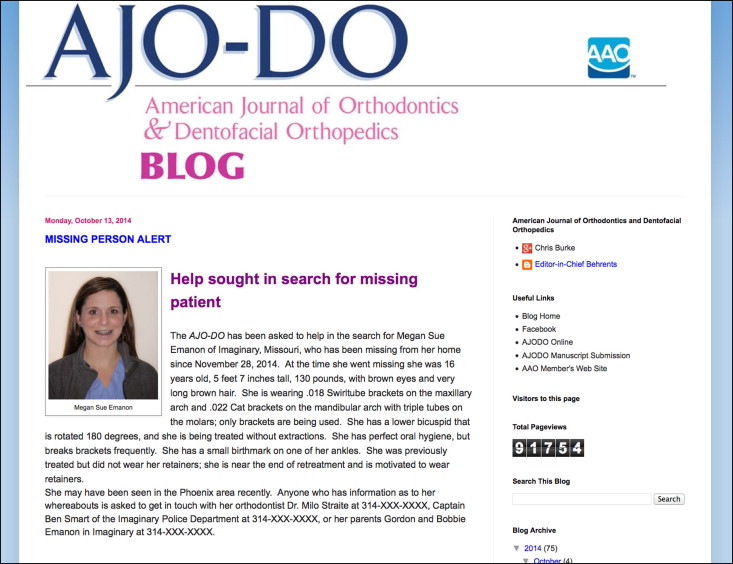It’s a normal busy day in the practice. One of your staff members comes and tells you that there is a parent in the waiting room with a teenaged girl, and they want to speak to you about the teen’s braces; then the staff member adds: “She is not a patient of record.” Well, most practitioners would consider this an unfavorable situation; at best, it could involve the first visit of a transfer patient, an assessment of someone else’s work (always a delicate situation), or the dreaded request to remove someone else’s braces. These situations are disruptive, but usual. Another situation, far from usual, is also possible: that the teen has been kidnapped, and her abductor is with her… in your waiting room.
Now, I know what you are thinking, but this situation can and does happen. According to the National Center for Missing and Exploited Children, in 2013, there were 462,567 entries for missing children under the age of 18 years into the FBI’s National Crime Information Center. This usually involves abductions by family members, but kidnappings by nonfamily members and runaways are also included. The murder of an abducted child is thankfully rare (approximately 100 cases per year), and this usually occurs within the first 3 days after the abduction.
What does this have to do with orthodontics? For one thing, one of your patients could go missing, and you and your colleagues might have the opportunity to help in finding him or her. A patient who is wearing orthodontic appliances will eventually need to seek orthodontic attention. You should know that this is not a new idea. I have spent some time with the old issues of the AJO-DO during this past year, and some of the intriguing entries that were published from time to time involved pleas for help in locating missing children (ie, patients). The first one that I came across was in 1957, but I also noted others in 1979 (2), 1981(2), 1985 (2), and 1999; I am sure there were more, but not recently. Out of curiosity, I contacted two of the orthodontists mentioned in the articles and also Wayne Watson (Editor-in-Chief, 1978-1985) to inquire whether they recalled that any of the missing children were ever found; none could recall whether the children were found, but they thought not. The 1999 article was requested by the FBI and involved a mother who had abducted her 2 children (ages, 8 and 11 years); the search was successful in a way—these 3 persons were found 13 years after they went missing.
Because of the great intentions of the previous program, but the poor success rate in locating missing children, why do this again? I think that we can do it much better today than in the past. Back then, it was not unusual for the child to go missing and then 6 to 10 months later the notice of “help sought in search for missing patient” would appear in the AJO-DO . I think you will all agree that with today’s technology, this lag time can be shortened considerably.
What is proposed is relatively simple. Once the orthodontist becomes aware that a patient is officially missing (the child must have been declared missing by the local authorities and reported to the National Center for Missing and Exploited Children), the orthodontist should ask the family whether he or she could help and ask them to sign a release (see the AJO-DO Blog for the release form). The orthodontist would then e-mail the form and a description of the patient and the orthodontic treatment, contact information, and relevant photographs to AJODOAlert@gmail.com . Once received, a missing child e-mail blast will be sent out indicating the general location of the abduction and direct the readers to the AJO-DO Blog, which will contain detailed information about the missing patient. We created a fictitious missing teenaged patient and a sample Blog post ( Fig ) to demonstrate how orthodontists could play a key role in locating and identifying a missing person. AJO-DO readers would be alerted to the post via an e-mail that might read “Help is sought in the search for a missing patient from the Missouri area. Details can be found on the AJO-DO Blog, ajodoblog.blogspot.com.”





